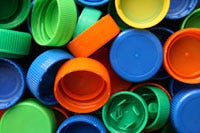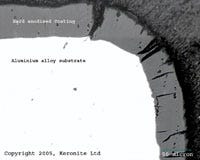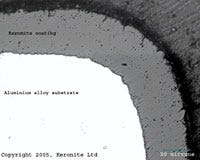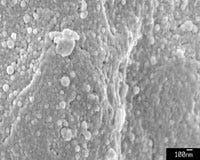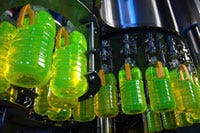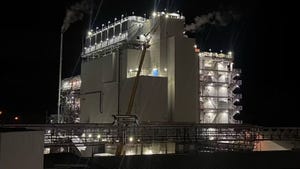Tough like steel – but aluminum
With the economic crunch hitting manufacturing, aluminum molds are looking more attractive. But what about tooling life? There might be an answer.Aluminum molds have always been a way to get a larger mold at a cheaper price. Typically aluminum machines faster, so build time is shorter, and it’s less costly than many steels. However, a major consideration in choosing an aluminum mold is the life of that mold. Aluminum wears faster particularly with more abrasive plastic materials, or when extremely high part volumes are required.
February 17, 2009
With the economic crunch hitting manufacturing, aluminum molds are looking more attractive. But what about tooling life? There might be an answer.
Aluminum molds have always been a way to get a larger mold at a cheaper price. Typically aluminum machines faster, so build time is shorter, and it’s less costly than many steels. However, a major consideration in choosing an aluminum mold is the life of that mold. Aluminum wears faster particularly with more abrasive plastic materials, or when extremely high part volumes are required.
|
Addressing this issue, Keronite International Ltd. (Cambridge, UK) introduced its Keronite plasma electrolytic oxidation (PEO) advanced surface treatment technology that the company promises will extend the life of aluminum molds far beyond that of their expensive steel counterparts, while providing the other benefits of aluminum molds such as improved heat transfer and the associated throughput rates. This patented, chrome-free solution to the problem of holding tight tolerances when molding high-volume parts from multicavity tools can also increase productivity and improve the quality of molded parts.
Keronite says PEO enables molding companies to reduce tool weight and handling costs as well as the time and expense involved in tool manufacturing, helping packaging companies to get products to market in record time. It points out that Keronite surfaces are considerably harder than those of hardened tool steel, in most cases as hard as titanium nitride or diamond chrome. Other performance advantages include dimensional control and superior adhesion to the substrate, according to Keronite.
The hardness of Keronite surfaces depends on the aluminum alloy used and the thickness of the ceramic layer created, but it can reach as much as 2000 HV. This is beyond the capabilities of hard anodizing and is even harder than steel, glass, and most silicon-containing compounds. This goes a long way toward creating a wear-resistant surface, but when combined with the substrate adhesion and the compliance of the Keronite layer, the results are outstanding, the company claims. With a modulus of only about 30 GPa, Keronite is extremely strain tolerant.
Keronite PEO coating is said to make a mold up to seven times more wear resistant than hard anodizing, thereby making aluminum molds extremely durable and able to minimize costly downtime for maintenance and repairs in high volume production.
During the Keronite process, the exposed aluminum surface is progressively converted into a thin ceramic layer, creating an interface with the base metal that is free from defects. Because of the way the ceramic layer is developed, it has much better adhesion to the substrate than other deposited coatings such as plasma-sprayed ceramics, thus reducing the risk of potentially costly surface chipping or flaking.
In addition to the inward growth, the Keronite layer also grows outward from the original surface, again in a controlled and predictable way, ensuring repeatability in high-volume production. The extent of this outward growth depends on the alloy selected, but it typically reaches between 10% and 40% of the total ceramic layer thickness.
Working with Keronite, tool designers can allow for the very slight surface growth when designing a new mold, or if a smoother surface is preferred, it is possible to polish the outer layer back to the original mold dimensions using conventional methods, wet blasting with corundum, plastic media, or nut shells in a liquid medium. Either way, tolerances remain tight and dimensions repeatable, making the process ideal for duplicate parts such as interchangeable cavity inserts, the company notes.
Keronite PEO is suitable for complex ribbed or textured molds, protecting against wear along edges and on vulnerable corners where conventional dip-plating or painting processes fail due to surface tension or “dog-bone” effects that produce thinner layers and weak spots. Hard-anodizing also offers limited protection in these critical areas because the nature of its columnar growth results in wedge-shaped cracks on tight radii, again creating vulnerability.
The surface treatment is particularly effective in preventing pitting or corrosion caused by gas burn, acid attack, or the chlorides and sulphides generated when certain types of plastics are heated. This protective layer also prevents corrosion caused by condensation and it enables the use of water-based resins without the usual associated problems, says Keronite International. With a reduced risk of corrosion, there are unlikely to be any oxidation byproducts contaminating the mold surface and causing problems in the more sensitive medical or electronics applications.
It’s suited for all mold types, but in the case of injection molding applications, tool wear can be an expensive problem in high-volume production, particularly in the areas directly opposite injection points. Keronite surfaces are not only resistant to hot or abrasive plastics and other additives such as glass or halogenated flame retardants, but also remain stable under temperature cycling.
Keronite’s PEO surface treatment service is available through its centers in the UK, the United States, and China, or the company can install equipment, supply electrolyte solutions, and provide engineering support to those companies wishing to treat their own components in-house or to coatings companies seeking to reach new markets. —[email protected]
About the Author(s)
You May Also Like
